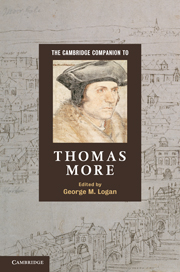Book contents
2 - Thomas More as humanist
from Part I - Life, times and work
Published online by Cambridge University Press: 28 May 2011
Summary
In 1439 the first books from the bequest of Humfrey, duke of Gloucester, arrived at Oxford, seeding the outlook of Italian humanism in the scholastic bower of the English medieval university. It is a date that will serve as well as any to announce the arrival in England of the new priorities associated with the subtle cultural stimulus that we now call ‘northern humanism’. In the subsequent unfolding of that influence its most celebrated exponent and disciple, in his own day and after, was Thomas More. Indeed, although his celebrity extends far beyond that of the humanist enterprise of the early Tudors, his achievement in that literary milieu of itself would have ensured his lasting reputation. His early intellectual formation also defines the period and manner in which northern humanism took root in England. By the time More arrived at Oxford around 1492, being some fourteen years of age, his privileged education had begun to prepare him to participate fully in the cultural sea-change foreshadowed by the reception of this new outlook on learning and civil life. We must therefore begin with a brief discussion of what is implied in the term ‘humanism’ as well as what is not.
The humanism of the European Renaissance was subtle precisely because it was not an ideology or philosophy. Its adherents could indeed be passionate in pursuit of aims that could be widely varied, but in their origins, the central texts of their enterprise were the same as those of the medieval university: the magisterial legacy of Greece and Rome, of antique grammar and rhetoric, of Aristotle and, especially in the north, of the foundational texts of Christian antiquity, notably those of scripture and the Church Fathers. This was the bedrock of European culture, revisited from time to time in a ‘classical revival’ marked by a fresh resort to antiquity and a new period of intellectual achievement.
- Type
- Chapter
- Information
- The Cambridge Companion to Thomas More , pp. 22 - 45Publisher: Cambridge University PressPrint publication year: 2011
- 5
- Cited by



